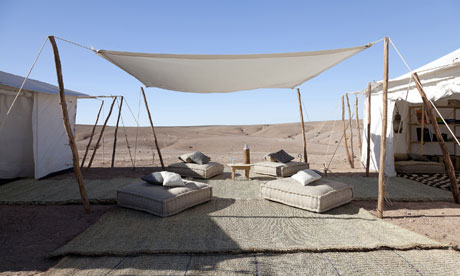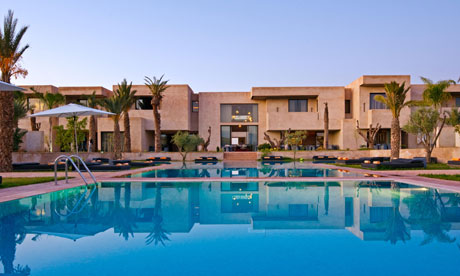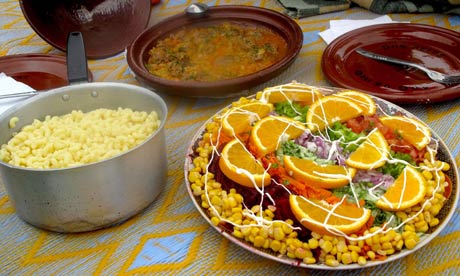THE TOUR in Morocco
Marrakech-"Morocco City",as early travellers called it -has always been something of a pleasure city,a marketplace where the southern tribesmen and Berber villagers bring in their goods, spend their money and find enter-trainment. For visitor it's an enduring fantasy - a city of immense beauty low, red and tentlike before a great shaft of montains-and immediately exciting. At the heart of it all is a square,Djemaa El Fna, really no more than an open space in the centre of the city, but the stage for a long-established ritual in which shifting cir-cles of onlookers and comedians. However many times you return there, it remains compelling. So, too, do the city's architectural attractions: the immense, still basins of the Agdal and Menara gardens, the delicate Granada-style carving of thesaadian tombs and, above all the Koutoubia Minaret, the most perfect Islamic monument in North Africa.
Unlike Fes, for so long its rival as the nation's capital, the city exists very much in the present. After Casablanca, Marrakesh is Morocco's second largest city and its population continues to rise. It has a thriving industrial area which reflects the rich farmlands of theHaouz plain which surround it: notably flour mills, breweries and canning factories. And it remains the most important market and administrative centre of southern Morocco. None of this is to suggest an easy prosperity-there is heavy unemployment here, as throughout the country, and intense poverty, too -but a stay in Marrakesh leaves you with a vivid impression of life and activity. And for once this doesn't apply exclusively to the new city, Gueliz; the Medina, substantially in ruins at the beginning of this century, was rebuilt and expanded during the years of French rule and retains no less significant a role in the modern city.
The Koutoubia excepted, Marrakesh is not a place of great monuments. Its beauty and attraction lie in the general atmosphere and spectacular location -with the magnificent peaks of the Atlas rising right up behind the city, towering through the heat haze of summer or shimmering white of winter. the feel, as much as anything, is a product of this. Marrakech has Berber rather than Arab origins, having developed as the metropolis of Atlas tribes-Maghrebis from the plains, Saharan nomads and former slaves from Africa beyond the desert, Sudan, Senegal and the ancient Kingdom of Timbuktu. All of these strands shaped the city's souks and its way of life, and in the crowds and performers in Djemaa El Fna, they can still occasionally seem distinct.
For most travellers, Marrakesh is the first experience of the south and-despite the inevitable 'false' guides and hustlers-of its generally more relaxed atmosphere and attitudes. Marrakchis are renowend for their warmth and sociability, their humour and directness-all qualities that (superficially, at least) can seem absent among the Fassis. there is, at any rate, a conspicuously more laid-back feel than anywhere in the north, with women, for example, having a greater degree of freedom and public presence, often riding mopeds around on the streets. And compared to Fes, Marrakesh is much less homogenous and cohesive. The city is more a conglomeration of villages than an urban community, with quarters formed and maintained by successive generations of migrants from the countryside.
For westerners, Morocco holds an immediate and enduring fascination. Though just an hour's ride on the ferry from Spain, it seems at once very far from Europe, with a culture Islamic and deeply traditional that is almost wholly unfamiliar. Throughout the country, despite the years of French and Spanish colonial rule and the presence of modern and cosmopolitan cities like Rabat or Casablanca , a more distant past constantly makes its presence felt. Fes, perhaps the most beautiful of all Arab cities, maintains a life still rooted in medieval time, when a Moroccan empire stretched from Senegal to northern Spain; while in the mountains of the Atlas and the Rif, it is still possible to draw up tribal maps of the Berber population. As a backdrop to all this, the country's physical make-up is also extraordinary: from a Mediterranean coast, through four mountain ranges, to the empty sand and scrub of the Sahara.
All of which makes travel in Morocco an intense and rewarding -if not always easy -experience. Certainly, there can be problems in coming to terms with your privileged position as tourist in a nation that, for the most part, would regard such activities as those of another world. And the northern Morocco cities especially have a reputation for hustlers: self appointed guides whose eagerness to offers their services -and whose attitude to tourists as being a justifiable source of income (and to women as something much worse) -can be hard to ideal with. If you find this to be too much of a struggle, then it would probably be better to keep to low-key resorts like Essaouira or Asilah, or to the more cosmopolitan holiday destination of Agadir, built very much in the image of its Spanish counterparts, or even a packaged sightseeing tour.
But you'd miss a lot that way. Morocco is at its best well away from such trappings. A week's hiking in the Atlas; a journey through the southern oases or into the pre-Sahara; or leisured strolls around Tangier, Fes or Marrakesh -once you adapt to a different way of life, all your time will be well spend. And it is difficult for any traveller to go for long without running into Morocco's equally powerful tradition of hospitality, generosity and openness. This is a country people return to again and again.
THE TAOURIRT CASBAH Approaching from the Boumalen road for Dadès, near to Ouarzazate is the casbah of Taourirt, a name that combines the Arab and Berber languages, meaning "hill fortress" - a structure that is of particular interest both for its fine architecture and its perfect integration into the environmental setting. Originally the residence of the pasha of Marrakesh and a symbol of the feudal period of the lords of Atlas, it consists of buildings that had a mainly military function and developed into a fortified city criss-crossed by numerous alleyways. There is a magnificient view from the terrace of the casbah. across to the mountains and the lake created by the Mansour ed- Dahbi dam, as far as the oases and enchanting Draa Valley.
morocco culture,moroccan food,morocco food,moroccan cuisine,morocco beaches,moroccan meal,beaches in morocco,moroccan culture,hercules cave,hercules cave morocco


